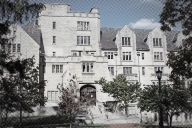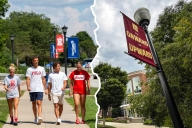You have /5 articles left.
Sign up for a free account or log in.
It began on Good Friday.
Administrators in the California State University system had already decided “we have to go to them,” as Charles B. Reed, chancellor of the California State University System, put it.
By “them,” Reed meant California ethnic and racial groups underserved by higher education. Many high school kids from underrepresented minority groups have never been on a university campus, nor have their parents. “If you’re invited to San Francisco State on Tuesday night to Smith Hall,” says Reed, “it’s a very foreign place.”
What Reed needed was a venue that people could trust, that had been a mainstay of the community, and that could answer questions without seeming either pedantic or intimidating.
So Reed called Bishop Charles Blake, pastor of West Angeles Church of God in Christ in South Central Los Angeles, and a leading figure in black Los Angeles. West Angeles has a membership of 22,000 strong. The church has two entire choruses, and, for Reed, it offered a captive audience of thousands. Blake and Reed decided to have a meeting of the minds to discuss how to get more black students, especially men, into college.
There are about 405,000 students on California State’s 23 campuses. About 6 percent -- 24,300 – of those students are black, nearly on par with the percentage of black people in the state of California. But only 7,200 of them are men. Having twice as many black women as black men is not uncommon in colleges across the nation, even those with large numbers of black students, but officials at Cal State would like to attract more black men. And for black students generally in the system, retention is a problem. Reed hopes that, by focusing on telling students not only that they are wanted, but how to prepare, graduation and retention rates will improve. Among the class that entered the Cal State system in 1999, about 27 percent of the black students graduated within six years, almost half the percentage for white students.
Experts told California State educators that many black students have little or no tradition of higher education in their families or communities, and many have never even had a black teacher to look up to. So, through coaches, community leaders, neighbors or peers, a culture of higher education must be manufactured.
Blake invited about 150 people, mostly black leaders, and Reed brought seven Cal State presidents along with admissions officers to the church. Discussions between Cal State representatives and church and community leaders about getting the Cal State word out became a monthly affair. And then, on February 26, came "Super Sunday."
On Super Sunday, armed with informational material and laptops, Cal State presidents and staff members, and even trustees, fanned out to eight churches in the Los Angeles area. They set up tables in the vestibules and prepared to answer any and all questions.
At West Angeles, Bishop Blake used part of his sermon to be the set-up man for the Cal State folks. Blake talked about the low numbers of black students in college, and about “the African American male not doing what needs to be done,” recalls Reed. Then Reed had about 15 minutes to talk. Reed and several other Cal State presidents and a trustee took to the podium -- and of course, to the accompanying video screen for church-goers in the nosebleed seats.
“I say to you, we have a crisis in education for our children,” exclaimed Herb Carter, a Cal State trustee.
Reed added that “in the past, college might have been optional,” he said. “But these days a college degree is the minimum requirement for getting a good job.”

Chancellor Charles B. Reed brought his education sermon to West Angeles Church.
People who only need first names go to West Angeles: Halle, Magic, Denzel, not to mention the Democratic political hopefuls who see West Angeles as a requisite stop. But it was Reed and his band upon which literally thousands of people descended once the service was over. “We know we passed out over 100,000 pieces of information,” Reed said. The information included posters that show a year-by-year planning guide for students who want to qualify for a Cal State institution; postcards that students could fill out to get set up with college mentors; and info about CSUMentor, an online guide to applying.
All in all, Cal State reached more than 20,000 people at eight different churches that day -- each of which, as a result of Cal State’s outreach, now has a contact person who can serve as a source of information about college. Reed’s staff had to drive back to Long Beach between the 8 a.m. and the 11 a.m. services to refill on posters -- available in multiple languages -- that outline benchmarks students should hit in each grade to become ready for college.
Students who take the required courses and have at least a 3.0 grade-point average are automatically eligible for admission. Eligibility for students with between a 2.0 and 3.0 GPA depends on standardized test scores. According to 2003 data from the California Postsecondary Education Commission, only 19 percent of black students were eligible for Cal State, and that’s of those who graduated high school. Only 11 percent who started as ninth graders eventually became eligible, as compared to 27 percent of white students, and 42 percent of Asian students.
“People stood in line for 40 minutes to ask questions,” says Reed. “They had children from 8-15 years old with them. They were starving for information, and they don’t get academic advice and counseling at their schools. They didn’t know how to apply, and that financial aid is available.”
Even before Super Sunday, Cal State officials said applications from black students are up this year -- with more outreach going on -- at the campuses in Los Angeles, San Bernardino, Long Beach and Northridge.
The keys to getting minority applications, says Reed, are “going to them, asking them what they need, and then following up and sustaining the effort.”
Steve Maradian, president of Los Angeles City College, a community college that is not part of the Cal State system, adds that the church is important for many people, but especially so in low-income black communities where a mother or grandmother with a long connection to the church may be the head of the household.
“Higher education tends to be intimidating,” says Maradian. “The ministers and pastors, and really any social group, can provide a backdrop to help educate families on what’s available in a non-demeaning way.”
Robert A. Corrigan, president of San Francisco State University, a Cal State campus, was part of a second Super Sunday this month -- this one in the Bay Area -- that reached thousands of people at a dozen churches. Corrigan says that churches are of particular importance, because outreach efforts need to reach not only students, but “neighbors and families.” Corrigan says that he went to college because “a neighbor took an interest in me.” Neither of Corrigan’s parents had graduated from high school. The neighbor happened to work with a member of Brown University’s local alumni association. With information from that connection, Corrigan ultimately won a scholarship to attend Brown. “People do recognize talent,” says Corrigan. “We’re just trying to broaden the support system.”
Maradian adds that “the church is only one step, but it’s absolutely critical. The pastor tends to stay for a long time, and it’s the only constant in a lot of people’s lives.”
For many black students, any constant presence pushing them toward college can make the difference. Getting black students into the college pipeline is difficult in areas where large percentages of black students, particularly men, “aren’t graduating high school,” says Tyrone Bledsoe, founder and executive director of the Student African American Brotherhood, “so there isn’t even a pipeline.”
SAAB, which began in 1990 as just a group of black men at Georgia Southwestern State University getting together to talk, has become a systematic, formal mentoring organization with chapters at 135 four-year institutions where black men advise each other as well as other black students at local schools.
“What ends up happening on the high school and two-year level,” says Bledsoe, “is you don’t have anyone who looks like you, who has been successful, who you can emulate. In K-12, the majority of teachers are white females. Not to suggest they can’t teach black male teachers … but many [black male students] have never had a single black male teacher.”
SAAB chapters “don’t have parties, no step shows,” says Bledsoe. “This is not a fraternity. They talk about issues that are germane to black males.” Students in a chapter receive mentoring from volunteer professionals from the community or the institution, and the students in turn become mentors to kids at local schools and junior colleges, and help them develop personal and professional goals.
With the help of a grant from the Lumina Foundation for Education, SAAB is running a pilot program with chapters at community colleges and high schools, with the hope of linking schools and colleges in the same area, so that black men might not long be underrepresented in the pipeline.
Maradian, for his part, has made a point of pushing talent along in the one place in higher education where black students, particularly black men, are often overrepresented: athletic teams. Maradian, former president of two-year Middle Georgia College, says there is one reason why an outstanding black athlete would end up at a junior college: because he or she did not qualify academically to play NCAA Division I athletics.
Such was the case for Kendrell Bell, 26, a Middle Georgia alum and former member of the football team. Bell said he was shy, and that the combination of being away from home for the first time, and not knowing anybody, added up to his being “depressed my first year.” Bell flunked out.
Maradian took over at Middle Georgia just in time. Bell says that Maradian changed everything from the cafeteria food to the faculty. And Bell says that Maradian quickly became a social presence on campus with his willingness to engage in spontaneous conversation with students. Bell says that, as a first generation student with little guidance, just talking made all the difference. “I was antisocial,” says Bell. “He brought it out of me, said it’s OK to talk. Then I learned more by socializing and picking people’s brains. I carried that into the classroom,” where Bell says he had previously felt “inferior.”
As far as Maradian was concerned, no topic was out of bounds when he spoke with students, and when Bell describes Maradian, he repeatedly turns to the phrase “like a father would.”
Bell says it got to the point where he’d accept criticism from Maradian that prepared him for his eventual jump to the University of Georgia. “He said, ‘you can look me in the eye when we talk,’ ” recalls Bell. “I thought I had a hearing problem. When I started looking at people when I was talking, I could actually understand what they were saying.”
Bell started making it in the classroom, and his star began to rise on the field. All the while, Maradian set a tone that let him know what order the priorities came in. Bell said that Maradian would often come around a corner asking about classes, and telling him that “on the field your life can end in eight seconds.”
By the time he got to the University of Georgia, Bell says he had the classroom and study skills he needed to succeed. “After junior college, Georgia was easy,” he says.
Bell ended up being one of the very few -- “you have a better chance of getting hit by lightning than getting into the [National Football League],” Corrigan says – who got to keep playing. He’s currently a linebacker for the Kansas City Chiefs. Next season will be his sixth in the NFL.
Bell says that Maradian’s behavior toward him has never flinched, even as he has become a celebrity. “It was never like, ‘I need a hundred tickets for my crew,’ ” Bell says. To this day, Maradian has remained a mentor and confidante, and Bell says he’s a very private person. “I only have five friends … he was someone I could open to.”
The ultimate success of students with wavering confidence in their academic ability can hinge, Bell says, on finding that one person that connects them to campus who they can talk to. “Sometimes it takes a while to get to them, sometimes it takes a couple words.”
For Reed, the most important words in crafting a plan to reach out to students like these are: “ ‘What do you need?’ You have to go to [underserved communities], and ask them what they need,” he says. “And then it has to be a sustained effort. They’ve had plenty of one-hit wonders.”








